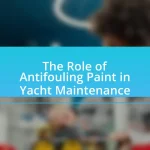Yacht design for extreme conditions encompasses specialized engineering and architectural practices aimed at creating vessels capable of enduring harsh maritime environments, including severe storms and icy waters. The article explores how yacht design adapts to extreme weather through the use of robust materials, advanced hydrodynamics, and innovative safety features, enhancing stability and performance. Key materials such as fiberglass, aluminum, and high-strength steel are highlighted for their essential roles in construction, while recent technological advancements and eco-friendly practices are discussed as vital components in modern yacht design. Additionally, the article addresses challenges in stability management, the importance of aerodynamics, and practical tips for potential yacht owners seeking vessels suited for adventurous voyages in extreme conditions.

What is Yacht Design for Extreme Conditions?
Yacht design for extreme conditions refers to the specialized engineering and architectural practices aimed at creating vessels capable of withstanding harsh maritime environments, such as severe storms, icy waters, and high winds. This design approach incorporates robust materials, advanced hydrodynamics, and safety features to ensure stability, durability, and performance under challenging circumstances. For instance, yachts designed for polar expeditions often utilize reinforced hulls made from high-strength steel or composite materials to resist ice impacts, while also featuring enhanced ballast systems to maintain equilibrium in turbulent seas.
How does yacht design adapt to extreme weather conditions?
Yacht design adapts to extreme weather conditions by incorporating robust materials, advanced hydrodynamics, and enhanced stability features. Designers utilize materials such as carbon fiber and aluminum to ensure structural integrity and reduce weight, which is crucial for performance in harsh environments. Additionally, hull shapes are optimized for better wave penetration and reduced drag, allowing yachts to navigate turbulent waters more effectively. Stability is further enhanced through features like deep keels and wide beams, which lower the center of gravity and improve resistance to capsizing. These adaptations are essential for ensuring safety and performance during extreme weather events, as evidenced by the design principles used in yachts participating in events like the Volvo Ocean Race, where vessels are specifically engineered to withstand severe conditions at sea.
What materials are essential for building yachts for harsh environments?
Essential materials for building yachts for harsh environments include fiberglass, aluminum, and high-strength steel. Fiberglass is favored for its lightweight and corrosion-resistant properties, making it suitable for various weather conditions. Aluminum offers a balance of strength and weight, providing durability while resisting rust, which is critical in marine environments. High-strength steel is utilized for its robustness and ability to withstand extreme forces, ensuring structural integrity in rough seas. These materials collectively enhance the yacht’s performance and longevity in challenging conditions.
How do design features enhance safety and performance in extreme conditions?
Design features enhance safety and performance in extreme conditions by incorporating advanced materials, structural integrity, and innovative technology. For instance, the use of high-strength composites and reinforced hull designs increases durability against harsh weather and impacts, ensuring the yacht can withstand extreme forces. Additionally, features such as self-righting capabilities and watertight compartments improve safety by preventing capsizing and flooding. Research indicates that yachts designed with these features can maintain stability and maneuverability in severe conditions, significantly reducing the risk of accidents.
Why is innovation crucial in yacht design for adventurous voyages?
Innovation is crucial in yacht design for adventurous voyages because it enhances safety, performance, and adaptability to extreme conditions. Advanced materials and technologies, such as carbon fiber and automated navigation systems, significantly improve a yacht’s structural integrity and maneuverability in harsh environments. For instance, the use of hydrodynamic hull designs allows for better fuel efficiency and stability in rough seas, which is essential for long-distance travel. Additionally, innovations like solar power integration and water desalination systems enable self-sufficiency, allowing yachts to operate effectively in remote areas without constant resupply. These advancements not only increase the overall experience of adventure but also ensure that the vessels can withstand the unpredictable nature of the ocean.
What recent technological advancements have influenced yacht design?
Recent technological advancements that have influenced yacht design include the integration of advanced materials, such as carbon fiber and lightweight composites, which enhance strength and reduce weight. These materials allow for more efficient hull designs that improve speed and fuel efficiency. Additionally, innovations in propulsion systems, such as hybrid and electric engines, have emerged, enabling yachts to operate more sustainably and with reduced emissions. Furthermore, advancements in navigation and automation technologies, including GPS and autonomous systems, have improved safety and ease of operation in extreme conditions. These developments collectively enhance performance, sustainability, and safety in yacht design for adventurous voyages.
How do innovative designs improve the overall sailing experience?
Innovative designs significantly enhance the overall sailing experience by integrating advanced materials, streamlined hull shapes, and user-friendly technology. These innovations lead to improved performance, safety, and comfort on the water. For instance, the use of lightweight composite materials reduces the weight of the yacht, allowing for faster speeds and better fuel efficiency. Additionally, hydrodynamic hull designs minimize drag, enabling smoother navigation through challenging waters. Furthermore, smart technology, such as automated sail systems and navigation aids, simplifies sailing for both novice and experienced sailors, enhancing overall enjoyment and safety. These advancements collectively contribute to a more efficient, enjoyable, and secure sailing experience.
What are the key challenges faced in designing yachts for extreme conditions?
The key challenges faced in designing yachts for extreme conditions include structural integrity, material selection, and stability management. Structural integrity is crucial as yachts must withstand high winds and waves, necessitating robust designs that can endure significant stress. Material selection is vital; lightweight yet durable materials like carbon fiber are often used to enhance performance while ensuring resilience against harsh environments. Stability management involves designing hull shapes that minimize capsizing risks and optimize buoyancy, which is essential for safety in turbulent waters. These challenges are compounded by the need for advanced technology integration, such as navigation systems that function reliably in extreme weather, ensuring both performance and safety during adventurous voyages.
How do designers address stability and buoyancy in rough seas?
Designers address stability and buoyancy in rough seas by incorporating advanced hull shapes, ballast systems, and materials that enhance performance. The use of a deep-V hull design allows for better cutting through waves, reducing slamming and improving stability. Additionally, designers often implement adjustable ballast systems that can shift weight to lower the center of gravity, enhancing stability during turbulent conditions. Materials such as lightweight composites are utilized to maintain buoyancy while ensuring structural integrity. These design strategies are supported by marine engineering principles that emphasize hydrodynamics and stability calculations, ensuring that yachts can withstand extreme conditions effectively.
What role does aerodynamics play in yacht performance during storms?
Aerodynamics significantly impacts yacht performance during storms by influencing stability, speed, and maneuverability. When a yacht is subjected to high winds and turbulent conditions, its aerodynamic design helps reduce drag and maintain control, allowing for better handling and responsiveness. For instance, streamlined hull shapes and optimized sail configurations can minimize wind resistance, enabling the yacht to navigate through rough seas more effectively. Research indicates that yachts designed with advanced aerodynamic principles can achieve up to 20% better performance in storm conditions compared to traditional designs, highlighting the critical role of aerodynamics in enhancing safety and efficiency during extreme weather events.
How do yacht designers ensure sustainability in extreme conditions?
Yacht designers ensure sustainability in extreme conditions by incorporating advanced materials and technologies that enhance energy efficiency and reduce environmental impact. For instance, they utilize lightweight composite materials that improve fuel efficiency and employ solar panels and wind turbines to harness renewable energy. Additionally, designers implement waste management systems that minimize pollution and promote recycling onboard. Research indicates that the use of hybrid propulsion systems can reduce emissions by up to 30%, demonstrating a commitment to sustainable practices in yacht design.
What eco-friendly materials are being used in modern yacht design?
Modern yacht design incorporates eco-friendly materials such as recycled aluminum, sustainable wood, and bio-composite materials. Recycled aluminum is favored for its lightweight properties and recyclability, reducing the environmental impact of yacht construction. Sustainable wood, sourced from responsibly managed forests, provides a renewable option for interiors and furnishings. Bio-composite materials, made from natural fibers and resins, offer strength and durability while minimizing reliance on petroleum-based products. These materials not only enhance the yacht’s performance but also align with the growing demand for environmentally conscious design in the marine industry.
How can yacht design minimize environmental impact during adventurous voyages?
Yacht design can minimize environmental impact during adventurous voyages by incorporating sustainable materials, energy-efficient systems, and advanced waste management solutions. Sustainable materials, such as recycled aluminum and eco-friendly composites, reduce the carbon footprint associated with construction. Energy-efficient systems, including solar panels and hybrid propulsion, decrease reliance on fossil fuels, leading to lower emissions. Advanced waste management solutions, like onboard treatment systems, ensure that waste is processed responsibly, preventing pollution in marine environments. These design innovations collectively contribute to a more sustainable approach to yachting, aligning with environmental conservation efforts.
What are the latest trends in yacht design for extreme conditions?
The latest trends in yacht design for extreme conditions focus on enhanced durability, advanced materials, and innovative hull shapes. Designers are increasingly utilizing carbon fiber and aluminum alloys to create lightweight yet robust structures that can withstand harsh environments. Additionally, the incorporation of hydrodynamic hull designs improves stability and performance in rough seas, while features like stabilizing fins and advanced propulsion systems enhance maneuverability. These trends are driven by the need for safety and efficiency in extreme maritime conditions, as evidenced by the growing popularity of expedition yachts that can operate in polar regions and other challenging environments.
How are smart technologies integrated into yacht design?
Smart technologies are integrated into yacht design through advanced automation systems, IoT connectivity, and energy-efficient solutions. These technologies enhance navigation, safety, and onboard comfort by utilizing sensors and data analytics to monitor performance and environmental conditions. For instance, integrated navigation systems can provide real-time weather updates and optimize routes, while smart energy management systems can monitor and control power consumption, ensuring efficient use of resources. Additionally, features like automated sail control and remote monitoring capabilities allow for improved handling and maintenance, making yachts more adaptable to extreme conditions.
What design elements are becoming standard for safety in extreme conditions?
Design elements becoming standard for safety in extreme conditions include reinforced hull structures, advanced stabilization systems, and improved safety equipment. Reinforced hulls utilize materials like carbon fiber and Kevlar to withstand harsh impacts and extreme weather, enhancing durability. Advanced stabilization systems, such as gyroscopic stabilizers, reduce roll and improve onboard comfort, which is crucial during turbulent conditions. Additionally, safety equipment like life rafts, EPIRBs (Emergency Position Indicating Radio Beacons), and integrated communication systems are now standard, ensuring quick response capabilities in emergencies. These elements collectively enhance the overall safety and reliability of yachts designed for extreme conditions.
What practical tips should be considered when choosing a yacht for extreme conditions?
When choosing a yacht for extreme conditions, prioritize a robust hull design, such as a reinforced fiberglass or aluminum construction, to withstand harsh environments. Additionally, consider the yacht’s stability features, including a low center of gravity and wide beam, which enhance performance in rough seas. The inclusion of advanced navigation and communication systems is crucial for safety and efficiency in remote areas. Furthermore, ensure the yacht has adequate storage for provisions and emergency supplies, as well as reliable power sources, such as solar panels or wind generators, to support extended voyages. These considerations are validated by industry standards, such as those set by the American Bureau of Shipping, which emphasize structural integrity and safety in yacht design for extreme conditions.
How can potential yacht owners assess the suitability of a design for their needs?
Potential yacht owners can assess the suitability of a design for their needs by evaluating specific criteria such as intended use, size, stability, and onboard amenities. Owners should consider how they plan to use the yacht, whether for leisure, long voyages, or extreme conditions, as this will influence design features like hull shape and materials. Stability is crucial for safety in rough waters, and designs that incorporate advanced hydrodynamics can enhance performance. Additionally, assessing the layout and amenities ensures that the yacht meets comfort and functionality requirements. Research indicates that designs tailored for extreme conditions often utilize innovative materials and technologies, which can significantly impact durability and performance, making them more suitable for adventurous voyages.
What maintenance practices are essential for yachts operating in harsh environments?
Essential maintenance practices for yachts operating in harsh environments include regular inspections, corrosion protection, and equipment checks. Regular inspections ensure that structural integrity is maintained, identifying any wear or damage caused by extreme weather conditions. Corrosion protection, such as applying anti-fouling paint and using sacrificial anodes, is crucial to prevent deterioration from saltwater exposure. Additionally, routine checks of critical systems like the engine, electrical components, and safety equipment help ensure reliability and performance under challenging conditions. These practices are supported by industry standards, such as those outlined by the American Bureau of Shipping, which emphasize the importance of proactive maintenance in prolonging the lifespan and safety of vessels in demanding environments.
















